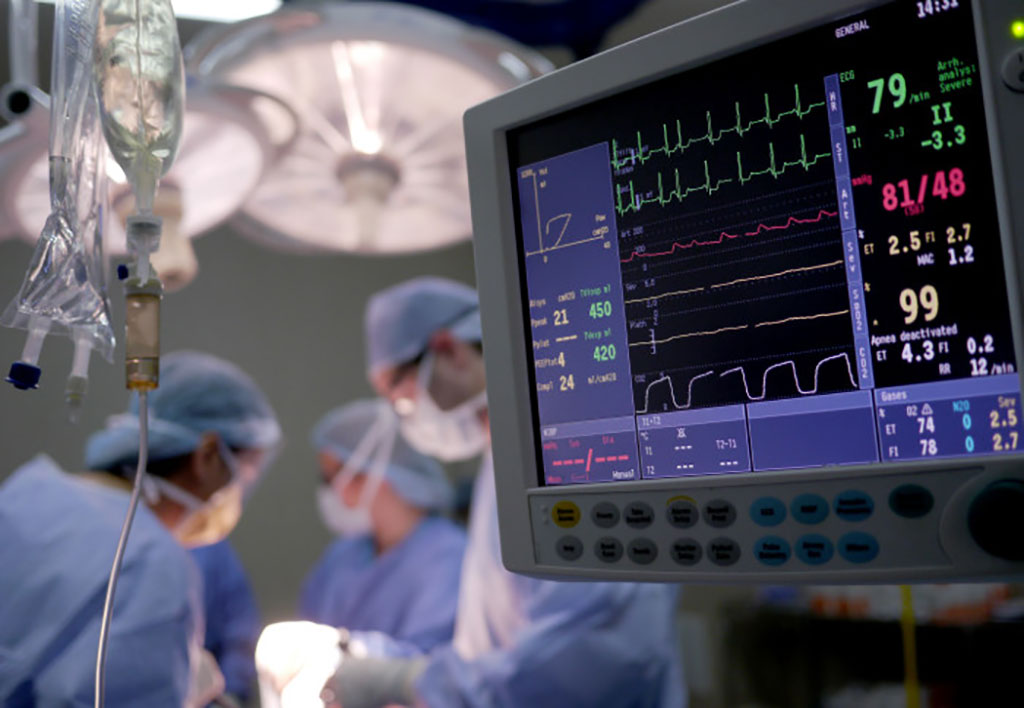Troponin Testing Could Improve Timing of Heart Surgery and Survival Rate
|
By HospiMedica International staff writers Posted on 04 Oct 2022 |

Troponin is a protein involved in muscle contraction that is released into the bloodstream after a heart attack. The higher the troponin levels, the more damaged the heart is. Clinicians use troponin levels, along with other tests, to determine whether a patient is having a heart attack and to decide on treatment options such as coronary artery bypass graft (CABG) surgery - a surgical procedure used to treat coronary heart disease. The optimal time to perform surgery following a heart attack remains unclear. Previous reports have suggested that carrying out surgery in the first few days following a heart attack is associated with a higher risk of surgical complications and death due to not giving enough time for the heart to recover. As a result, following a heart attack, many patients who need bypass surgery wait for more than 10 days before surgery is performed.
Now, a new study has found that some patients who have lower levels of troponin would benefit from having earlier surgery. However, the researchers show that patients with very high troponin levels should have surgery postponed, as their risk of dying was higher if surgery was performed within 10 days of their heart attack. There was no benefit in delaying surgery for those with low levels of troponin, according to the findings. The researchers suggest that early surgery for heart attack patients with lower troponin levels would reduce overall length of stay and ease pressure on resources such as staff.
The large study led by Imperial College London (London, UK) is the first multicentre study to investigate the interaction between the extent of heart damage, as indicated by troponin levels, and the optimal time to wait for surgery in a large series of heart attack patients. The study reviewed patients who had a type of heart attack called a non-ST segment elevation myocardial infarction (NSTEMI) due to a blockage to their coronary arteries - which supply blood to the heart - who required a CABG. This is a procedure that uses veins, usually from the legs, or arteries from the chest or arm to bypass the blockage and restore blood flow and oxygen to heart muscle.
Around 20% of NSTEMI patients have a CABG. However, the optimal timing for CABG surgery in patients with uncomplicated NSTEMI has been unclear. Prior to the new research, some studies had suggested that early surgery was associated with higher mortality post operation. This has led to a tendency for CABG to be delayed if a patient’s condition remains stable. However, other studies had reported similar mortality rates after early versus late surgery, concluding that delaying surgery in all patients after uncomplicated NSTEMI is not warranted and does not improve outcomes. No previous study had investigated in a large group of patients whether there was an association between the extent of heart damage (as measured by troponin levels) and the wait for surgery on survival.
In the new study, the team analyzed data from the NIHR HIC of 1746 patients with NSTEMI and unstable angina (UA) - a condition in which the heart doesn’t get enough blood and oxygen, leading to a heart attack. The cohort consisted of 1684 patients with NSTEMI and 62 with UA. The average age of the group was 69 and 21% were female. They underwent CABG within 90 days at five different cardiac centers before their surgery between 2010 and 2017. The researchers compared patients’ troponin levels, wait between surgery and outcomes after surgery within the first 30 days and over a period of five years.
They found that the pre-operative troponin level was a strong predictor of early mortality, and this was significantly influenced by the interval to surgery. The average wait for patients with high troponin levels to surgery was nine days. Sixty patients died within 30 days after surgery and another 211 patients died over a period of five years following surgery. They found that for those who had troponin levels of less than 100 times the normal upper limit, delaying surgery to after 10 days was not associated with lower survival. For patients with higher troponin levels, early survival increased progressively with a longer time to surgery – survival was highest in those who had surgery after day 10. The effect of troponin levels pre-operation on survival was limited to the first 30 days after surgery. Late survival was determined by other risk factors, such as age and other co-morbidities such as hypertension. The team says more work is needed in the form of prospective trials to assess the impact of troponin and timing of surgery on survival following a heart attack.
“For patients with troponin levels of under 100 times the normal upper limit, extending the waiting time or surgery did not improve early survival,” said Dr. Amit Kaura, lead author of the research. “This finding is particularly significant as two-thirds of patients presenting with troponin levels of under 100 are waiting on average 12 days for surgery after being admitted to hospital. There are potential cost saving implications with our research by performing earlier surgery in this group of patients with lower troponin levels.”
Related Links:
Imperial College London
Latest Surgical Techniques News
- Minimally Invasive Endoscopic Surgery Improves Severe Stroke Outcomes
- Novel Glue Prevents Complications After Breast Cancer Surgery
- Breakthrough Brain Implant Enables Safer and More Precise Drug Delivery
- Bioadhesive Sponge Stops Uncontrolled Internal Bleeding During Surgery
- Revolutionary Nano Bone Material to Accelerate Surgery and Healing
- Superior Orthopedic Implants Combat Infections and Quicken Healing After Surgery
- Laser-Based Technique Eliminates Pancreatic Tumors While Protecting Healthy Tissue
- Surgical Treatment of Severe Carotid Artery Stenosis Benefits Blood-Brain Barrier
- Revolutionary Reusable Duodenoscope Introduces 68-Minute Sterilization
- World's First Transcatheter Smart Implant Monitors and Treats Congestion in Heart Failure
- Hybrid Endoscope Marks Breakthrough in Surgical Visualization
- Robot-Assisted Bronchoscope Diagnoses Tiniest and Hardest to Reach Lung Tumors
- Diamond-Titanium Device Paves Way for Smart Implants that Warn of Disease Progression
- 3D Printable Bio-Active Glass Could Serve as Bone Replacement Material
- Spider-Inspired Magnetic Soft Robots to Perform Minimally Invasive GI Tract Procedures
- Micro Imaging Device Paired with Endoscope Spots Cancers at Earlier Stage
Channels
Critical Care
view channel
Light-Based Technology to Measure Brain Blood Flow Could Diagnose Stroke and TBI
Monitoring blood flow in the brain is crucial for diagnosing and treating neurological conditions such as stroke, traumatic brain injury (TBI), and vascular dementia. However, current imaging methods like... Read more
AI Heart Attack Risk Assessment Tool Outperforms Existing Methods
For decades, doctors have relied on standardized scoring systems to assess patients with the most common type of heart attack—non-ST-elevation acute coronary syndrome (NSTE-ACS). The GRACE score, used... Read moreSurgical Techniques
view channel
Minimally Invasive Endoscopic Surgery Improves Severe Stroke Outcomes
Intracerebral hemorrhage, a type of stroke caused by bleeding deep within the brain, remains one of the most challenging neurological emergencies to treat. Accounting for about 15% of all strokes, it carries... Read more
Novel Glue Prevents Complications After Breast Cancer Surgery
Seroma and prolonged lymphorrhea are among the most common complications following axillary lymphadenectomy in breast cancer patients. These postoperative issues can delay recovery and postpone the start... Read morePatient Care
view channel
Revolutionary Automatic IV-Line Flushing Device to Enhance Infusion Care
More than 80% of in-hospital patients receive intravenous (IV) therapy. Every dose of IV medicine delivered in a small volume (<250 mL) infusion bag should be followed by subsequent flushing to ensure... Read more
VR Training Tool Combats Contamination of Portable Medical Equipment
Healthcare-associated infections (HAIs) impact one in every 31 patients, cause nearly 100,000 deaths each year, and cost USD 28.4 billion in direct medical expenses. Notably, up to 75% of these infections... Read more
Portable Biosensor Platform to Reduce Hospital-Acquired Infections
Approximately 4 million patients in the European Union acquire healthcare-associated infections (HAIs) or nosocomial infections each year, with around 37,000 deaths directly resulting from these infections,... Read moreFirst-Of-Its-Kind Portable Germicidal Light Technology Disinfects High-Touch Clinical Surfaces in Seconds
Reducing healthcare-acquired infections (HAIs) remains a pressing issue within global healthcare systems. In the United States alone, 1.7 million patients contract HAIs annually, leading to approximately... Read moreHealth IT
view channel
Printable Molecule-Selective Nanoparticles Enable Mass Production of Wearable Biosensors
The future of medicine is likely to focus on the personalization of healthcare—understanding exactly what an individual requires and delivering the appropriate combination of nutrients, metabolites, and... Read moreBusiness
view channel
Philips and Masimo Partner to Advance Patient Monitoring Measurement Technologies
Royal Philips (Amsterdam, Netherlands) and Masimo (Irvine, California, USA) have renewed their multi-year strategic collaboration, combining Philips’ expertise in patient monitoring with Masimo’s noninvasive... Read more
B. Braun Acquires Digital Microsurgery Company True Digital Surgery
The high-end microsurgery market in neurosurgery, spine, and ENT is undergoing a significant transformation. Traditional analog microscopes are giving way to digital exoscopes, which provide improved visualization,... Read more
CMEF 2025 to Promote Holistic and High-Quality Development of Medical and Health Industry
The 92nd China International Medical Equipment Fair (CMEF 2025) Autumn Exhibition is scheduled to be held from September 26 to 29 at the China Import and Export Fair Complex (Canton Fair Complex) in Guangzhou.... Read more
















